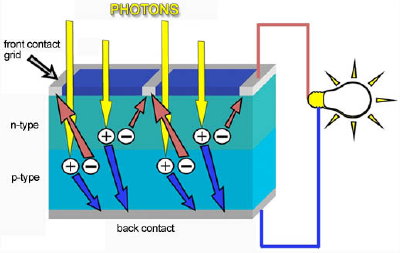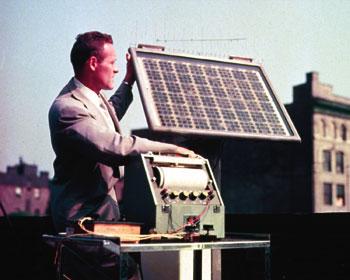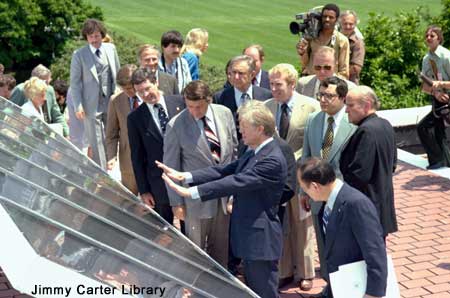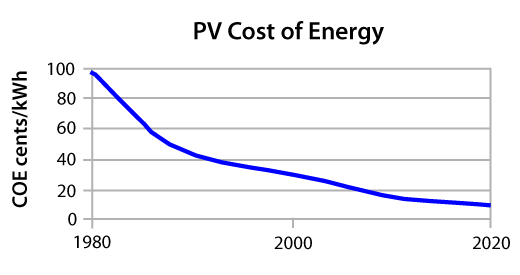A solar cell (also called a photovoltaic cell) is an electrical device that converts the energy of light directly into electricity by the photovoltaic effect. It is a form of photoelectric cell (in that its electrical characteristics. current, voltage, or resistance vary when light is incident upon it) which, when exposed to light, can generate and support an electric current without being attached to any external voltage source.
The photovoltaic effect was first experimentally demonstrated by French physicist A. E. Becquerel. In 1839, at age 19, experimenting in his father's laboratory, he built the world's first photovoltaic cell. However, it was not until 1883 that the first solid state photovoltaic cell was built, by Charles Fritts, who coated the semiconductor selenium with an extremely thin layer of gold to form the junctions. The device was only around 1% efficient. In 1888 Russian physicist Aleksandr Stoletov built the first photoelectric cell based on the outer photoelectric effect discovered by Heinrich Hertz earlier in 1887.
Albert Einstein explained the underlying mechanism of light instigated carrier excitation--the photoelectric effect-- in 1905, for which he received the Nobel prize in Physics in 1921. Russell Ohl patented the modern junction semiconductor solar cell in 1946, which was discovered while working on the series of advances that would lead to the transistor.
The first practical photovoltaic cell was developed in 1954 at Bell Laboratories by Daryl Chapin, Calvin Souther Fuller and Gerald Pearson. They used a diffused silicon p-n junction that reached 6% efficiency, compared to the selenium cells that found it difficult to reach 0.5%. At first, cells were developed for toys and other minor uses, as the cost of the electricity they produced was very high; in relative terms, a cell that produced 1 watt of electrical power in bright sunlight cost about $250, comparing to $2 to $3 per watt for a coal plant.
Solar cells were brought from obscurity by the suggestion to add them to the Vanguard I satellite, launched in 1958. In the original plans, the satellite would be powered only by battery, and last a short time while this ran down. By adding cells to the outside of the body, the mission time could be extended with no major changes to the spacecraft or its power systems. There was some skepticism at first, but in practice the cells proved to be a huge success, and solar cells were quickly designed into many new satellites, notably Bell's own Telstar.
Improvements were slow over the next two decades, and the only widespread use was in space applications where their power-to-weight ratio was higher than any competing technology. However, this success was also the reason for slow progress; space users were willing to pay anything for the best possible cells, there was no reason to invest in lower-cost solutions if this would reduce efficiency. Instead, the price of cells was determined largely by the semiconductor industry; their move to integrated circuits in the 1960s led to the availability of larger boules at lower relative prices. As their price fell, the price of the resulting cells did as well. However these effects were limited, and by 1971 cell costs were estimated to be $100 per watt.
It was through funding from Exxon that Dr. Elliot Berman developed a cheaper solar cell. Berman discovered that, while lowering efficiency, using silicon from multiple crystals was much cheaper than using the silicon from a single crystal. That development brought the price down fivefold. Solar cells were now used in offshore gas and oil rigs, and began to be seen as an alternative energy source in remote off-grid locations. In the meantime, with the help of greater funding for solar research, new varieties of silicon were developed, allowing for the widening of uses for solar energy. Since the 2000s, PV solar panels have become affordable and practical for residential use, and are widely used in non-residential applications,
In 2010, a tremendous growth of solar PV cell shipments doubled the solar PV cell market size. According to the solar PV market research company,PVinsights, Suntech topped the ranking of solar cell production. Most of the top ten solar PV producers doubled their shipment in 2010 and five of them were over one gigawatt shipments.The top ten solar cell producers dominated the market with an even higher market share, say 50~60%, with respect to an assumed twenty gigawatt cell shipments in 2010.
 Besides, next-generation solar cells will come into being along with the development of new materials, new structures and new technologies. Currently, quantum dot solar cells, quantum well solar cells, dye sensitization cells, hot photovoltaic cell and organic thin-film or Carbon nanotube composites in the photoactive layer, solar cells are emerging for the purpose of reducing production costs and energy consumption and increasing the photoelectric transformation efficiency and the proportion of renewable energy. While there is a steady rise of people willing to follow Germany's example when in 1999, the German government introduced the 100,000 Roof Programme and there was no looking back after that. According to the German Solar Industry Association BSW Solar, at the end of 2011, Germany had an installed capacity of about 25 GWp of solar, of which about 85% of the capacity is on rooftops. The incentives to instal becomes that much greater when fixed incomes are earned or used to offset household bills, as well as Investment returns of over 8-10%, Guaranteed quarterly income paid by your Utility company,
Income Payments TAX FREE and a better Energy Rating of your home.
Besides, next-generation solar cells will come into being along with the development of new materials, new structures and new technologies. Currently, quantum dot solar cells, quantum well solar cells, dye sensitization cells, hot photovoltaic cell and organic thin-film or Carbon nanotube composites in the photoactive layer, solar cells are emerging for the purpose of reducing production costs and energy consumption and increasing the photoelectric transformation efficiency and the proportion of renewable energy. While there is a steady rise of people willing to follow Germany's example when in 1999, the German government introduced the 100,000 Roof Programme and there was no looking back after that. According to the German Solar Industry Association BSW Solar, at the end of 2011, Germany had an installed capacity of about 25 GWp of solar, of which about 85% of the capacity is on rooftops. The incentives to instal becomes that much greater when fixed incomes are earned or used to offset household bills, as well as Investment returns of over 8-10%, Guaranteed quarterly income paid by your Utility company,
Income Payments TAX FREE and a better Energy Rating of your home.






This comment has been removed by the author.
ReplyDelete